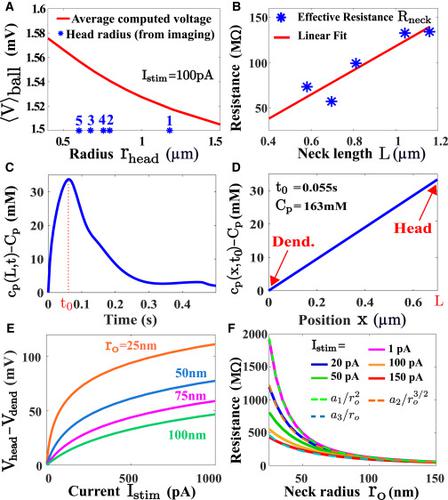Our official English website, www.x-mol.net, welcomes your feedback! (Note: you will need to create a separate account there.)
Deconvolution of Voltage Sensor Time Series and Electro-diffusion Modeling Reveal the Role of Spine Geometry in Controlling Synaptic Strength.
Neuron ( IF 16.2 ) Pub Date : 2018-Mar-07 , DOI: 10.1016/j.neuron.2018.01.034 Jerome Cartailler 1 , Taekyung Kwon 2 , Rafael Yuste 2 , David Holcman 1
Neuron ( IF 16.2 ) Pub Date : 2018-Mar-07 , DOI: 10.1016/j.neuron.2018.01.034 Jerome Cartailler 1 , Taekyung Kwon 2 , Rafael Yuste 2 , David Holcman 1
Affiliation

|
Most synaptic excitatory connections are made on dendritic spines. But how the voltage in spines is modulated by its geometry remains unclear. To investigate the electrical properties of spines, we combine voltage imaging data with electro-diffusion modeling. We first present a temporal deconvolution procedure for the genetically encoded voltage sensor expressed in hippocampal cultured neurons and then use electro-diffusion theory to compute the electric field and the current-voltage conversion. We extract a range for the neck resistances of 〈R〉=100±35MΩ. When a significant current is injected in a spine, the neck resistance can be inversely proportional to its radius, but not to the radius square, as predicted by Ohm's law. We conclude that the postsynaptic voltage cannot only be modulated by changing the number of receptors, but also by the spine geometry. Thus, spine morphology could be a key component in determining synaptic transduction and plasticity.
中文翻译:

电压传感器时间序列的反卷积和电扩散建模揭示了脊柱几何形状在控制突触强度中的作用。
大多数突触兴奋性连接是在树突棘上进行的。但是仍然不清楚棘突中的电压如何通过其几何形状进行调制。为了研究棘突的电特性,我们将电压成像数据与电扩散模型相结合。我们首先为海马培养的神经元中表达的遗传编码电压传感器提出了一个时间反卷积程序,然后使用电扩散理论来计算电场和电流-电压转换。我们提取〈R〉 = 100±35MΩ的颈部电阻的范围。当在脊柱中注入大量电流时,如欧姆定律所预测的那样,颈部阻力可能与其半径成反比,但与半径平方成反比。我们得出的结论是,不能仅通过改变受体的数量来调节突触后电压,而且还受脊柱几何形状的影响。因此,脊柱形态可能是决定突触传导和可塑性的关键组成部分。
更新日期:2018-02-09
中文翻译:

电压传感器时间序列的反卷积和电扩散建模揭示了脊柱几何形状在控制突触强度中的作用。
大多数突触兴奋性连接是在树突棘上进行的。但是仍然不清楚棘突中的电压如何通过其几何形状进行调制。为了研究棘突的电特性,我们将电压成像数据与电扩散模型相结合。我们首先为海马培养的神经元中表达的遗传编码电压传感器提出了一个时间反卷积程序,然后使用电扩散理论来计算电场和电流-电压转换。我们提取〈R〉 = 100±35MΩ的颈部电阻的范围。当在脊柱中注入大量电流时,如欧姆定律所预测的那样,颈部阻力可能与其半径成反比,但与半径平方成反比。我们得出的结论是,不能仅通过改变受体的数量来调节突触后电压,而且还受脊柱几何形状的影响。因此,脊柱形态可能是决定突触传导和可塑性的关键组成部分。



























 京公网安备 11010802027423号
京公网安备 11010802027423号